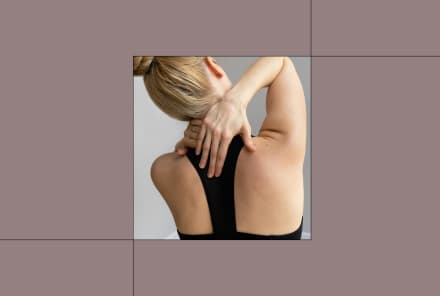Advertisement
3 Barre Exercises To Increase Blood Flow While Working At A Desk

The average American sits for six to eight hours per day, according to the American Heart Association’s report. Studies have linked long periods of sitting with an increased risk for diabetes, heart disease, and even cancer. Sedentary behaviors have also been shown to increase anxiety and high mortality rates.
The cure isn’t just exercising more—it is sitting less. For every 30 minutes of sitting, it is recommended to move for a minimum of 1 minute and 45 seconds. Our bodies weren't made to sit all day; however, the sitting state is almost inevitable—in the car, at the desk, or in meetings. Sitting is what we do the majority of our days, but physically our or bodies weren't developed for it. Sitting all day takes a toll on our bodies and can increase the risk for heart disease and skeletal issues, but how do we avoid the urge to sit?
Try your hand at these Barre-inspired exercises, designed to help you move while at your desk.
3 Barre moves to do at your desk.
Ideal for: Slow digestion
Standing Core Work with a Resistance Band or Towel (duration: 1-2 minutes)
Sitting all day or slumping over a computer can affect your digestion1 by compressing the gut. As the shoulders round forward and the rib cage presses in and down, the body’s weight adds pressure on the gut. Compression in the gut slows down the digestive process and can cause bloating. To combat this, practice good posture when sitting and standing. Breathing exercises can strengthen the diaphragm and core muscles to help improve the flow of digestion.
This simple standing core exercise is a great one to do at one's desk. I recommend using a stretchy exercise/resistance band or a small towel to assist with the moves.
- Standing as tall as possible with the feet hip-width apart and parallel, hold each end of the band or towel in each hand; lift arms forward and up so the hands are shoulder height; arms should be separated only shoulder distance. Correct posture is important to counterbalance the sitting, so make sure the shoulders are drawing down, away from the ears, and the shoulders are stacked above the hips.
- Take a soft bend to both knees; draw the abdominal muscles in to help the tailbone drop slightly underneath the body and toward the floor; draw the belly button in toward the spine; keep the core muscles engaged.
- Start to inhale and exhale slowly; focus on drawing the belly in and out with the breath; option to add a tiny pull out on the band; exhale, draw the belly in toward the spine, and at the same time pull the band apart just an inch; inhale, release the breath, and release the pull on the band; repeat for 1 to 2 minutes; focus on maintaining proper body alignment.
Ideal for: Poor circulation
Standing calf raises (duration: 30-60 seconds)
Sitting for long periods can reduce circulation to the legs. Poor circulation can lead to ankle swelling, varicose veins, and even blood clots. Symptoms of poor circulation can be tingling or numbness in the feet, legs and feet may start to feel cold, and an overall sense of fatigue. These sensations can be increased if women are sitting with their legs crossed. For a quick energy boost and to get the blood pumping to the legs, try calf raises (heel lifts).
The simple heel lift gets more blood flowing through the legs, strengthens the ankles and the knees, stretches the fronts of the shins, and tones calves, hamstrings, and glutes.
- Find a sturdy desk or chair for support, one hand on the support and one hand on the opposite hip.
- Bring the heels together and the toes apart, making a V-shape with the feet; stand as tall as possible; lengthen the neck and the spine upward; squeeze the heels, and grip the gluteal muscles.
- Keep the upper body still; start to lift and lower the heels slowly up and down; start with 20 to 30 seconds of calf lifts and work on progressing up to 60 seconds.
Ideal for: Relieving back pain
Standing Glute Work (Gluteal Work) (duration: 2 minutes on each leg)
Prolonged sitting can weaken the gluteal muscles, which can tighten the hip flexors, can lead to more of an anterior (forward) pelvic tilt, deepen the lumbar curve, and this affects posture. This not only causes back pain but also can make the gluteal muscles appear flat. Gluteal muscles are designed for intense activity, and unless they are worked intensely, they can become weak or "lazy" and will let other muscles (like hamstrings) happily do all the work. Weak glutes also result in our back being less supported (the lumbar curve may fall forward, called lordosis), sending a chain reaction of instability to the hips and knees.
For these reasons, Barre exercises help students learn how to locate these hard-to-reach muscles and develop the skills to engage them without inadvertently recruiting other muscles.
- Stand near a desk or sturdy chair that can be used for balance; feet are hip-width apart and parallel, both hands resting on the support; bend both of the knees slightly; drop tailbone, core firmly engaged.
- Pick up the left foot; bend the left knee; bring the left heel toward the left glute; flex the left foot, engage the gluteus maximus muscle (muscle in the center of the seat) to move the left knee slightly behind the left hip; keeping the left leg slightly behind the right leg also works to give the left hip and thighs a lengthening stretch.
- Engage the seat muscles to get the left leg to press back and hold. The key is to feel the gluteal muscles working. Press back, hold 20 to 30 times, and then switch sides.
Whether it be with Barre, Pilates, or dynamic stretching, working to counteract the effects of sitting could be the way through in a world where we're accustomed to taking a seat—perhaps for much longer than necessary.
Want to incorporate other exercises into your daily routine to help combat the effects of sitting? Check out these 7 exercises to get the body moving.
Watch Next
Enjoy some of our favorite clips from classes
Enjoy some of our favorite clips from classes
What Is Meditation?
Mindfulness/Spirituality | Light Watkins
Box Breathing
Mindfulness/Spirituality | Gwen Dittmar
What Breathwork Can Address
Mindfulness/Spirituality | Gwen Dittmar
The 8 Limbs of Yoga - What is Asana?
Yoga | Caley Alyssa
Two Standing Postures to Open Up Tight Hips
Yoga | Caley Alyssa
How Plants Can Optimize Athletic Performance
Nutrition | Rich Roll
What to Eat Before a Workout
Nutrition | Rich Roll
How Ayurveda Helps Us Navigate Modern Life
Nutrition | Sahara Rose
Messages About Love & Relationships
Love & Relationships | Esther Perel
Love Languages
Love & Relationships | Esther Perel











